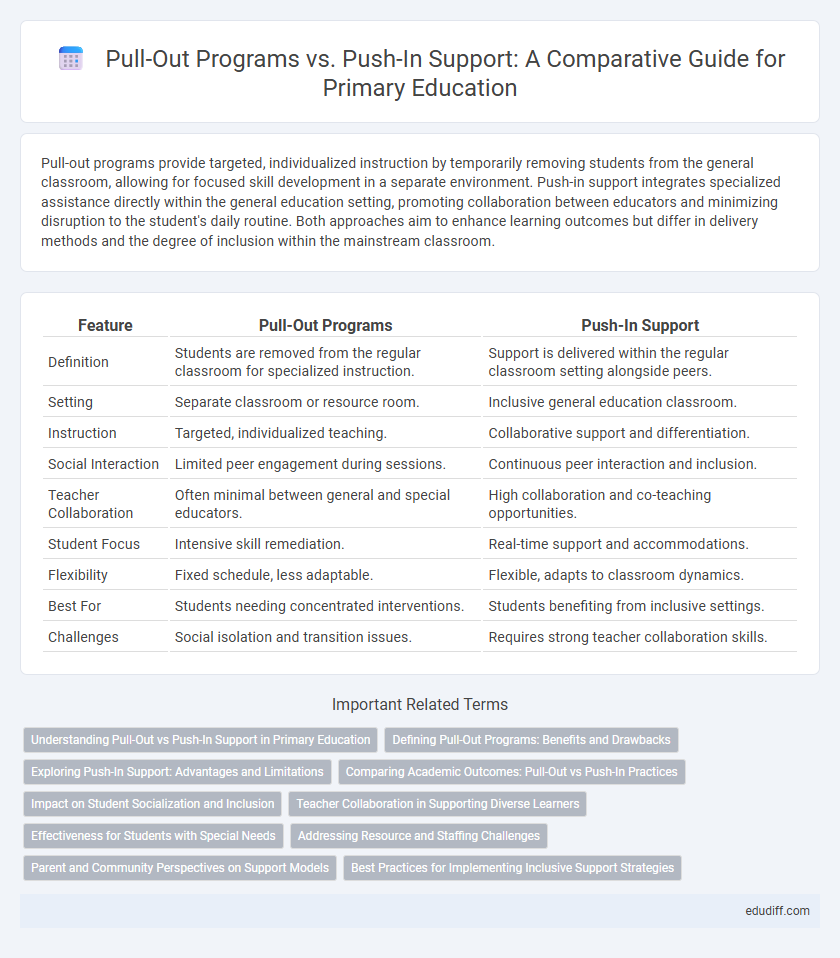Pull-out programs provide targeted, individualized instruction by temporarily removing students from the general classroom, allowing for focused skill development in a separate environment. Push-in support integrates specialized assistance directly within the general education setting, promoting collaboration between educators and minimizing disruption to the student's daily routine. Both approaches aim to enhance learning outcomes but differ in delivery methods and the degree of inclusion within the mainstream classroom.
Table of Comparison
| Feature | Pull-Out Programs | Push-In Support |
|---|---|---|
| Definition | Students are removed from the regular classroom for specialized instruction. | Support is delivered within the regular classroom setting alongside peers. |
| Setting | Separate classroom or resource room. | Inclusive general education classroom. |
| Instruction | Targeted, individualized teaching. | Collaborative support and differentiation. |
| Social Interaction | Limited peer engagement during sessions. | Continuous peer interaction and inclusion. |
| Teacher Collaboration | Often minimal between general and special educators. | High collaboration and co-teaching opportunities. |
| Student Focus | Intensive skill remediation. | Real-time support and accommodations. |
| Flexibility | Fixed schedule, less adaptable. | Flexible, adapts to classroom dynamics. |
| Best For | Students needing concentrated interventions. | Students benefiting from inclusive settings. |
| Challenges | Social isolation and transition issues. | Requires strong teacher collaboration skills. |
Understanding Pull-Out vs Push-In Support in Primary Education
Pull-out programs in primary education involve removing students from the general classroom to receive specialized instruction in a separate setting, allowing for focused support tailored to individual needs. Push-in support occurs when specialists provide assistance within the mainstream classroom, promoting inclusivity and continuous engagement with peers during learning activities. Understanding the benefits and challenges of pull-out versus push-in models helps educators optimize interventions for academic and social development in young learners.
Defining Pull-Out Programs: Benefits and Drawbacks
Pull-out programs involve removing students from the general classroom for specialized instruction, allowing targeted support in areas such as reading or speech therapy. Benefits include personalized attention and tailored interventions that address specific learning needs, which can accelerate skill development. Drawbacks consist of reduced exposure to mainstream classroom activities and potential social isolation, which may impact inclusion and peer interactions.
Exploring Push-In Support: Advantages and Limitations
Push-in support integrates specialized instruction within the general education classroom, fostering inclusivity and real-time collaboration between educators and students. This approach boosts peer interaction and reduces stigma, promoting a more comprehensive learning experience for students with diverse needs. Limitations include potential challenges in meeting individual needs discreetly and requiring extensive teacher training to effectively implement differentiated strategies.
Comparing Academic Outcomes: Pull-Out vs Push-In Practices
Pull-out programs provide targeted, individualized instruction by removing students from the general classroom, often resulting in higher gains in skill-specific areas like reading fluency and math problem-solving. Push-in support keeps students within the general education setting, promoting inclusion and social interaction while facilitating real-time collaboration between special educators and classroom teachers. Studies reveal mixed academic outcomes, with pull-out models boosting focused skill development and push-in models enhancing engagement and access to broader curriculum content.
Impact on Student Socialization and Inclusion
Pull-out programs often isolate students from their peers during critical social interaction times, potentially hindering socialization and feelings of inclusion within the primary classroom. Push-in support allows students to remain integrated with their classmates, promoting natural social interactions and reinforcing inclusive learning environments. Research shows that inclusive practices like push-in support contribute to improved social skills and greater acceptance among primary students.
Teacher Collaboration in Supporting Diverse Learners
Effective teacher collaboration enhances the success of both Pull-Out Programs and Push-In Support by fostering shared strategies tailored to diverse learners' needs. Pull-Out Programs allow specialized instructors to deliver targeted interventions, while Push-In Support integrates expertise within the general classroom, promoting real-time co-teaching and differentiated instruction. Collaborative planning and communication among educators ensure consistency, maximize resource utilization, and improve academic outcomes for students requiring additional support.
Effectiveness for Students with Special Needs
Pull-out programs provide individualized instruction by separating students with special needs from the general classroom, allowing targeted interventions that address specific learning challenges. Push-in support integrates specialized assistance within the general education setting, promoting inclusive learning and real-time collaboration between special educators and classroom teachers. Research indicates that combining both approaches, tailored to individual student profiles, maximizes academic growth and social development for students with special needs.
Addressing Resource and Staffing Challenges
Pull-out programs provide targeted, individualized instruction by removing students from the general classroom, allowing educators to address specific learning needs with specialized resources and staff. Push-in support integrates additional educators within the mainstream classroom, optimizing existing staffing by promoting collaboration and minimizing disruptions to core instruction. Balancing pull-out and push-in models helps schools manage limited resources effectively while meeting diverse student needs through strategic deployment of specialized personnel.
Parent and Community Perspectives on Support Models
Parent and community perspectives highlight distinct preferences in pull-out programs versus push-in support models, emphasizing individualized attention versus inclusive classroom engagement. Many parents appreciate pull-out programs for providing targeted interventions tailored to specific learning needs, resulting in measurable academic progress. Community feedback often favors push-in support for promoting social integration and minimizing stigmatization, aligning with inclusive education goals and fostering collaborative teacher-parent partnerships.
Best Practices for Implementing Inclusive Support Strategies
Pull-Out Programs provide targeted interventions by removing students for specialized instruction, allowing for focused skill development in a controlled environment. Push-In Support integrates specialists within the general classroom, promoting collaboration and real-time assistance that enhances inclusivity and peer interaction. Best practices emphasize combining both methods based on student needs, ensuring clear communication between educators, ongoing progress monitoring, and flexible scheduling to maximize learning outcomes.
Pull-Out Programs vs Push-In Support Infographic

 edudiff.com
edudiff.com